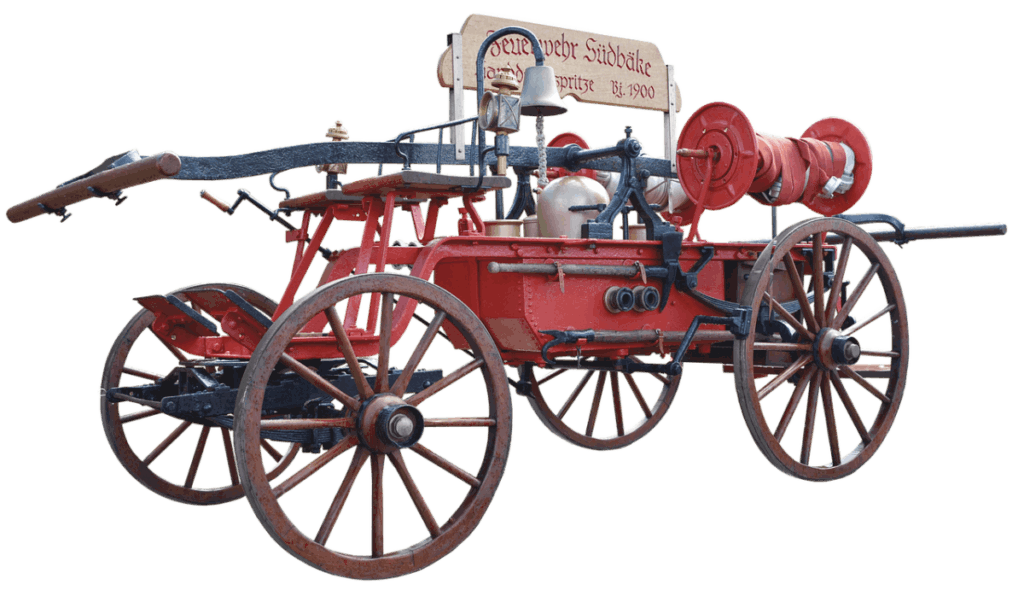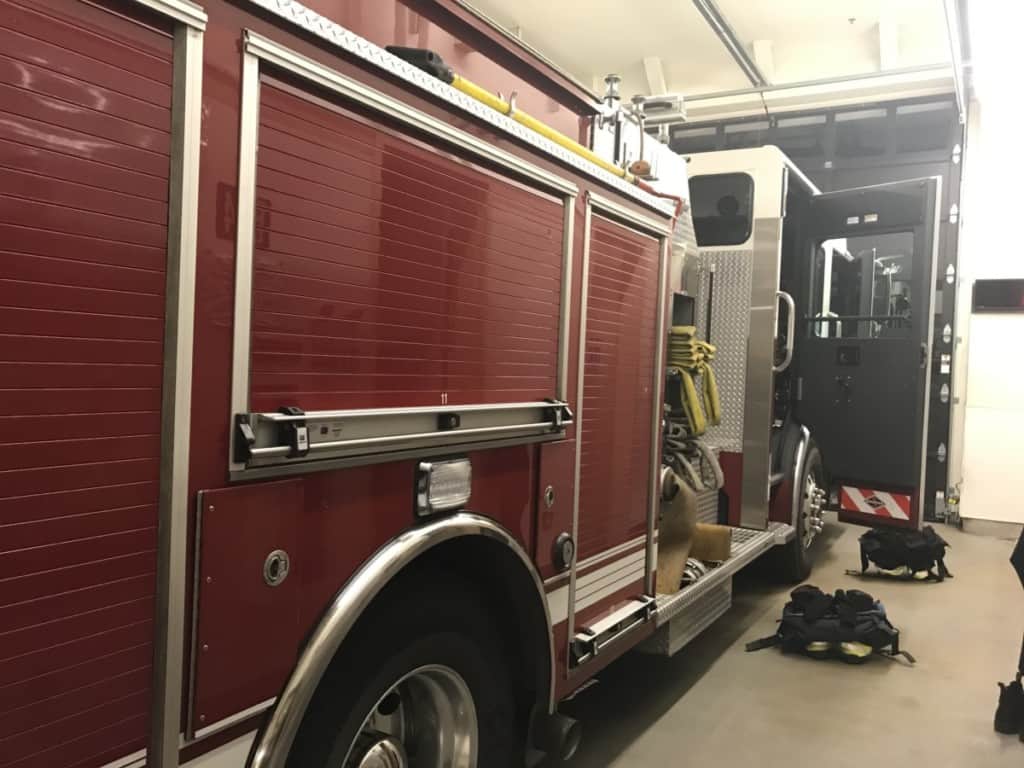When firefighters are called to an emergency, the crew of 3 to 5 firefighters get on to the engine or truck in their assigned spots. Not every firefighter is responsible for driving and there is a chain of command dictating each crew member’s role. In other words, there’s not a lot of calling, “Shotgun!”
Not all firefighters have to drive the fire truck. The driver engineer or driver operator is mainly responsible for driving, pumping, and maintaining the fire truck or engine. Other firefighters may drive sometimes as an “Acting Driver” when staffing requires it.
This is a complex answer because it relies on the ranking system of the fire service. So, while many firefighters can drive the truck, many of them do not. First, let’s look at what it takes to drive a fire truck.
Your # 1 priority is keeping your family safe. As a firefighter, I recommend everyone has updated smoke detectors that don’t require battery changes, like these ones from Kidde, a fire extinguisher, like this one from Amerex, and a fire escape ladder if you have bedrooms above the first floor, I recommend this one from Hausse.
Also read: How to Become a Firefighter Driver/Engineer
What It Takes To Drive A Fire Apparatus
Note: Many people use the terms fire truck and fire engine interchangeably, but they are actually different types of vehicles. To learn about what makes them different, read: What’s the Difference Between a Fire Engine and a Fire Truck?
Fire trucks can be upwards of 40 feet long and weigh over 50,000 pounds. Driver engineers (also called chauffeurs or driver operators), who are the primary operator of the fire apparatus, need to be competent and experienced as they safely respond and navigate these large vehicles to emergency calls.
Driver engineers must get through fire department specific driver training programs. Depending on the jurisdiction, these programs can last anywhere from a few weeks to a few months. Driver engineers are generally working with a commercial driver’s license (CDL)(Class A or B) or Firefighter Endorsement with a Class C driver’s license, depending on the city and state requirements. These certifications allow firefighters to drive the truck in emergency and non-emergency situations.
Note: If you need to get a commercial driver’s license to drive a fire truck in your area, here is a great study guide to help you pass the tests.
Aside from what type of license one possesses, a clean driving record is an important quality anyone getting behind the wheel of the fire truck should have. Those driving the truck must be constantly aware of the traffic and motorists around them at all times, ready to decide on the best directions to get to the scene safely. Firefighter and civilian safety are of the utmost importance at all times.
Though many departments will train their “tailboard” firefighters (the first level firefighter who rides in the back of the engine) to drive the trucks when staffing needs them to, this is not always the case. Most departments view the rank of Driver/Engineer as a promotion from the rank of firefighter. In addition to driving, driver engineers are responsible for operating all equipment on their apparatus (water pumps, aerial ladders, generators, etc.) and must perform frequent checks on the engine to ensure it is in working order, as well as keep all equipment cleaned and maintained after every call.
This video gives you a better look at the job of driver/engineer:
Also read: How Much Water Does A Fire Truck/Fire Engine Hold?
Can You Be a Firefighter Without a Driver’s License?
Although not all firefighters have to drive the fire engines and trucks, you still need a driver’s license. Almost all fire departments will require a valid driver’s license in order to become a firefighter. This may not be the case to become a volunteer firefighter, but it is required to be a paid firefighter.
Firefighter Ranks
Fire service was born out of the military, so its chain of command is militaristic in many ways. As firefighters progress through the ranks, they must serve a minimum amount of time at each level and complete additional testing for each new position, in order to progress in their careers. All ranks have their own responsibilities and while some overlap as they work together as a team, each role carries its own set of specialties, such as who drives the truck.
Probationary Firefighters
Probationary firefighters are recruits that have been hired as an entry-level employee.
As the lowest ranking member, they undergo training for 12 to 24 months of additional training, observation, and extra responsibilities before becoming permanent members.
Firefighter
While all of the ranks are firefighters, this is the basic rank of firefighter (sometimes called “tailboard”). The rank of the firefighter involves putting out fires, search and rescue, and being hands-on at the scene of an emergency.
The firefighter may drive the fire truck in the absence of the driver/engineer (as an “acting driver/engineer), assuming he or she has the appropriate training. There are usually one to two ranked firefighters in a company/firehouse.
Driver Engineer
The driver engineer manages, maintains and operates the fire truck, pump and ladder. He or she may also take the role of “acting lieutenant” or “acting captain” in the company officer’s absence.
Other terms for driver engineer include: D/E, chauffeur, apparatus operator, or fire equipment operator.
Lieutenant
While on the scene of an emergency, the lieutenant is responsible for the management of resources and personnel. They are the company officer (leader of the crew). When not supervising an emergency, the lieutenant is managing daily operations at the fire company and leading firefighter training. The lieutenant may assume the role of the “acting captain” in the absence of the captain.
Note: Not all fire departments have the rank of lieutenant, many skip right to captain.
Captain
The captain is a company officer and may function the same as a lieutenant in many departments. Similar to the lieutenant, the captain also oversees daily operations and training at the fire company, while also overseeing their lieutenants.
Captains must have good leadership, management, and public speaking skills due to the requirements of their rank.
Battalion Chief
Of all the ranks, the battalion chief is usually the highest-ranking officer on duty. There are usually three rotating battalion chiefs per department to make sure that the position can be staffed 24 hours a day, 7 days a week. They are the chief officers on emergency calls and will usually function as the Incident Commander (in charge of and oversee all the other crews).
Battalion chiefs are responsible for scheduling, which may sound simple, but is actually complex, given the specialized roles of each rank in a fire company, the number of people in each rank, and any additional necessary EMS required to be on hand.
Assistant Chief
Assistant chiefs manage personnel, provide technical and support services to the chief and handle administrative functions. The assistant chief is also responsible for creating budgets to upkeep and expand the fire service.
Fire Chief
The fire chief is the main leader and supervisor of all roles in the department. He or she is directly accountable for the efficient operation of the fire department and has full control of its personnel and activities.
The fire chief also has a say in other department functions such as:
- Fire safety education
- Fire protection
- EMS
- Disaster preparedness
In addition to being the leader of the department, the fire chief is often viewed as a community leader and responsible for making sure constituents are safe. They will usually report to the city manager.
Fire Apparatus History

Firefighters didn’t always drive fire trucks, in fact, early firefighters often didn’t use vehicles at all. 400 years ago, firefighters would carry around a hand pump which would spray water, often fed by a bucket from an assisting firefighter or civilian.
In the mid-19th century, horse-drawn fire engines first became popular. This is viewed as a major advancement in firefighting as it significantly sped up fire response times. Before this, firefighters typically dragged equipment to the scene of a fire on skids.
Alongside the rise of automobiles in the early 1900s, the idea of using a gas-powered engine to transport water pumps became popular. This idea can actually be found in engineering magazines published at the time. A company called Knox Automobile, based in Massachusetts, is credited with creating the first modern fire truck, which quickly achieved success.
As populations began to move into cities from rural areas, buildings grew taller and firefighters needed a way to reach the tall heights. Daniel D. Hayes, a San Francisco firefighter (though he did work for New York City Fire Department prior) developed the first extension ladder that could be mounted to the fire truck and allow firefighters to rescue victims. As technology developed, these ladders changed from being manually operated to mechanically operated. After world war two, the cherry picker bucket was added to the top of ladders.
Today, the terms “fire truck” and “fire engine” are often used interchangeably, but fire departments refer to these as very different fire fighting apparatus.
Fire engines generally do not have aerial ladders and serve the primary purpose of extinguishing fires, transporting firefighters to the scene, and pumping water. Fire trucks will have at least 1 ladder or aerial apparatus and are often used for search and rescue, gaining access to heights, and forced entry.
Read more about this here: What’s the Difference Between a Fire Engine and a Fire Truck?
Related Articles
What Is a Firefighter Endorsement?

